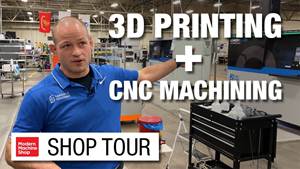“Military aircraft are held hostage by long supply chains,” says James Regenor, founder of VeriTX. “It can take 87 weeks to receive a forging or casting, and then another 4 to 6 months of lead time to actually get a needed aircraft part.”
The scenario is based on Regenor’s career in the Air Force, but it likely sounds familiar to other end users and manufacturers of critical equipment. Procuring a near-net form of a metal part is a significant and time-consuming step in a manufacturing process that may already span weeks. Coupled with the realities of shipping and border crossings, the need to store or source tooling, and possible challenges and costs to reverse engineer the needed component, the time and money needed to source these components can be staggering.
VeriTX promises to change this, to make it faster and more affordable to source needed parts anywhere in the world. The B2B service provider will function as a bridge between OEMs who design equipment systems, and the users and manufacturers who need parts to build, repair or maintain these systems. VeriTX allows OEMs to securely upload digital rights-managed (DRM) part files to an online hub where buyers with the right qualifications can download them to manufacture the parts anywhere in the world they are needed. Blockchain technology keeps these transactions secure, and, for now, additive manufacturing (AM) is the production process that enables this model of distributed manufacturing.
“Tool-less” Technology As a Starting Point
Although Regenor has plans to expand the service to include parts intended for other kinds of processes, he sees additive manufacturing as the first natural place to start. After retiring from the Air Force, Regenor worked for Moog, the aerospace OEM that for a time owned 3D printing service bureau Linear Mold (now Linear AMS). Having previously been on the receiving end of needed spare parts, Regenor now saw a possible solution for making them. As a leader of Moog’s aircraft military aftermarket division, he witnessed firsthand how the 3D printing technology used at Linear could deliver parts and spares on a more rapid timeline. In 2018 Regenor left Moog to pursue the project that would become VeriTX, based on the promise of AM for rapid, distributed manufacturing.

Col. James Allen Regenor, U.S. Air Force (retired) and founder of VeriTX Corp. in front of a bank of polymer 3D printers. The digital, tool-less 3D printing process makes it the best fit for the company’s distributed manufacturing model at the moment. Photo Credit: Stephan Gabris for VeriTX Corp.
Additive manufacturing is sometimes referred to as a “tool-less” process, and this is the key to its speed relative to conventional manufacturing. With AM, there is no mold to build, no casting or forging to source. 3D printing compresses the process, and the supply chain along with it. Digital files can move across borders with ease even when physical goods cannot. Simply put, a 3D printer with the right material, settings and part file can build that part anywhere in the world, no tooling required.
VeriTX pairs these principles with a blockchain solution to offer a secure supply chain marketplace for needed parts. The service allows OEMs to upload their part files securely into the VeriTX database where qualified service providers and end users can access them for as-needed 3D printing in situ. Blockchain secures the part files in transit, and biometrics ensure that only designated individuals on the receiving end can access them.
The company is now close to launch, and has a number of successful case studies under its belt to prove that this distributed manufacturing model is not only possible but effective. In one proof-of-concept study, for instance, VeriTX demonstrated how a plastic replacement part for a business class seat on a commercial plane could be produced within just one hour, as a flight was underway; by the time the aircraft touched down at its destination, the part could be waiting on the runway, ready to install.
Aerospace parts for military and commercial crafts will be the company’s main focus at first, but future expansions to the system will include support for spare parts in other highly regulated markets, as well as manufacturing technologies beyond 3D printing.
For much more on this distributed manufacturing and supply chain solution, see this feature on AdditiveManufacturing.media.
Related Content
Designing a 3D Printed Part with Machining in Mind
Designing extra stock and mounting features into a 3D printed part can aid in machining processes downstream.
Read MoreThe Cool Parts Showcase Seeks Innovative 3D Printed Parts
Do you solve problems with 3D printing? Enter your 3D printed parts in this contest from The Cool Parts Show.
Read MoreThe Benefits of Vertically Integrating Metal 3D Printing and Machining
Having 3D printing and machining within one organization enables Addman’s engineers to collaborate and consolidate so it can quickly make successful metal 3D printed parts.
Read MoreView From My Shop, Episode 2: 3D Printing and Postprocessing With Tangible Solutions
Collaboration between Tangible Solutions’ additive and machining departments simplifies their work. Learn more in this episode of The View From My Shop.
Read MoreRead Next
A Characterization of Blockchain Technology
If you are not an information technology person or an accountant, you may be struggling to figure out what blockchain technology is all about. Here’s a simple way to understand it.
Read MoreCan Blockchain Help Machine Shops Win Work?
The record-keeping system underlying cryptocurrencies like Bitcoin could automate the front office, secure intellectual property and plug data-driven manufacturers into increasingly data-driven supply chains.
Read MoreLower Buy-to-Fly Ratios with Near-Net Additive Manufacturing
Building up large parts with wire-arc metal 3D printing rather than machining from solid has allowed this aerospace manufacturer to reduce its buy-to-fly ratio dramatically.
Read More

.jpg;width=70;height=70;mode=crop)


.JPG;maxWidth=150;quality=70)









.png;maxWidth=300;quality=90)











.JPG;maxWidth=400;quality=70)
